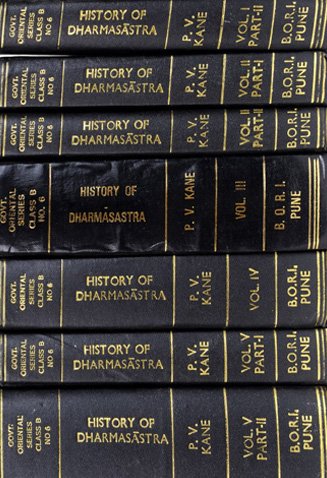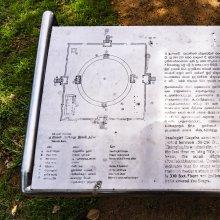Pradakshina, Pradakṣiṇā, Pradakṣiṇa: 20 definitions
Introduction:
Pradakshina means something in Buddhism, Pali, Hinduism, Sanskrit, the history of ancient India, Marathi, Hindi. If you want to know the exact meaning, history, etymology or English translation of this term then check out the descriptions on this page. Add your comment or reference to a book if you want to contribute to this summary article.
The Sanskrit terms Pradakṣiṇā and Pradakṣiṇa can be transliterated into English as Pradaksina or Pradakshina, using the IAST transliteration scheme (?).
Images (photo gallery)
In Hinduism
Purana and Itihasa (epic history)
Source: archive.org: Shiva Purana - English TranslationPradakṣiṇā (प्रदक्षिणा) refers to the “rite of circumambulation” and is mentioned in the Śivapurāṇa 1.20, while explaining the mode of worshipping an earthen phallic image (pārthiva-liṅga) according to the Vedic rites:—“[...] the wise devotee shall then perform the Pradakṣiṇā (circumambulation) with the mantra ‘Mā No Mahāntam’ and the intelligent one shall perform Sāṣṭānga (eight limbs touching the ground) prostration with the mantra ‘Mā Nastoke’ etc.”.
According to the Śivapurāṇa 2.2.19, as Brahmā narrated to Nārada:—“[...] I approached the Goddess (Satī) and performed in detail all the sacrificial rites as laid down in the Gṛhyasūtras. Then at my bidding in the capacity of the main priest, Śivā and Śiva duly and with great delight performed the circumambulation (pradakṣiṇa) of the sacred fire”.

The Purana (पुराण, purāṇas) refers to Sanskrit literature preserving ancient India’s vast cultural history, including historical legends, religious ceremonies, various arts and sciences. The eighteen mahapuranas total over 400,000 shlokas (metrical couplets) and date to at least several centuries BCE.
Dharmashastra (religious law)
Source: Oxford Academic: Homo Ritualis: Hindu Ritual and Its Significance to Ritual TheoryPradakṣiṇā (प्रदक्षिणा) refers to “circumambulation (of the fire)”, and represents one of the traditional marriage rituals, according to Dadhirāma Marāsini’s 19th century Vivāhapaddhati (part of his Karmakāṇḍabhāskara) which is based on the Pāraskara-Gṛhyasūtra, a domestic manual in the Mādhyandina school of the Vājasaneyisaṃhitā.—If performed traditionally, high caste marriages among the Parbatiyas (Parbates/Paharis/Pahadis) or Indo-Nepalese people in Nepal are normally executed by following the course of events as presented in marriage manuals. The Agni-pradakṣiṇā rite is mentioned under the header called Other vivāha rites.

Dharmashastra (धर्मशास्त्र, dharmaśāstra) contains the instructions (shastra) regarding religious conduct of livelihood (dharma), ceremonies, jurisprudence (study of law) and more. It is categorized as smriti, an important and authoritative selection of books dealing with the Hindu lifestyle.
General definition (in Hinduism)
Source: ACHC: Smarta PujaPradakṣiṇa (प्रदक्षिण) refers to “offering circumambulation”, representing one of the various services (upacāra) of a pūjā (ritualistic worship of a deity) which aim at the purification of the devotee.—Pradakṣinā (pradakṣa) is the walking around an object clockwise, always keeping it to one’s right side to show respect. If this is not possible the devotee may also turn around himself on the spot: For Śiva only half a Pradakṣinā is allowed, that means that the devotee returns to his starting point after half a circumambulation without crossing the chute which conveys water from the liṅga (soma-sūtra). The circumambulation is said to imitate the daily movement of the sun and is believed to shake off evil, it is already mentioned in the Śrauta-sūtras and Gobhila-gṛhya-sūtra.
In Buddhism
Mahayana (major branch of Buddhism)
Source: academia.edu: A Study and Translation of the GaganagañjaparipṛcchāPradakṣiṇa (प्रदक्षिण) refers to “adequately (grasping)”, according to the Gaganagañjaparipṛcchā: the eighth chapter of the Mahāsaṃnipāta (a collection of Mahāyāna Buddhist Sūtras).—Accordingly, “Through these ten immeasurables (apramāṇa), son of good family, the Bodhisattva completes the accumulations of merit (puṇya-saṃbhāra). What are these ten? [...] (8) completion of the immeasurable enjoyment of the circle of hair between the eyebrows by accumulating endless offerings; (9) completion of the immeasurable, invisible crown of the head by serving teachers (guru) with endless homage and conquering pride; (10) completion of the immeasurable unfailing courage (amogha-vikrānti) by adequately grasping (pradakṣiṇa-graha) the coming and going without deception or guile (māyāśāṭhya). [...]”.

Mahayana (महायान, mahāyāna) is a major branch of Buddhism focusing on the path of a Bodhisattva (spiritual aspirants/ enlightened beings). Extant literature is vast and primarely composed in the Sanskrit language. There are many sūtras of which some of the earliest are the various Prajñāpāramitā sūtras.
India history and geography
Source: Cologne Digital Sanskrit Dictionaries: Indian Epigraphical GlossaryPradakṣiṇa.—(CITD), circumambulation from left to right; paying homage to a temple, etc., by solemnly walking round it with the right hand towards it, so that the right side is always turned towards the person or object circumambulated; a rever- ential salutation made by walking in this manner. Note: pradakṣiṇa is defined in the “Indian epigraphical glossary” as it can be found on ancient inscriptions commonly written in Sanskrit, Prakrit or Dravidian languages.

The history of India traces the identification of countries, villages, towns and other regions of India, as well as mythology, zoology, royal dynasties, rulers, tribes, local festivities and traditions and regional languages. Ancient India enjoyed religious freedom and encourages the path of Dharma, a concept common to Buddhism, Hinduism, and Jainism.
Languages of India and abroad
Marathi-English dictionary
Source: DDSA: The Molesworth Marathi and English Dictionarypradakṣiṇa (प्रदक्षिण).—ad S To the right--turning, revolving, circumambulating.
--- OR ---
pradakṣiṇā (प्रदक्षिणा).—f (S) Circumambulation of an object (esp. of an idol or a Brahman by way of reverence) keeping the right side towards it. Pr. lakṣa pra0 āṇi paisā dakṣiṇā. 2 Sometimes used of circumambulation without reference to the hand; as in sōmasūcīpradakṣiṇā.
Source: DDSA: The Aryabhusan school dictionary, Marathi-Englishpradakṣiṇa (प्रदक्षिण).—ad To the right-turning &c.
--- OR ---
pradakṣiṇā (प्रदक्षिणा).—f Circumambulation of an object keeping the right side to- wards it. Circumambulation.
Marathi is an Indo-European language having over 70 million native speakers people in (predominantly) Maharashtra India. Marathi, like many other Indo-Aryan languages, evolved from early forms of Prakrit, which itself is a subset of Sanskrit, one of the most ancient languages of the world.
Sanskrit dictionary
Source: DDSA: The practical Sanskrit-English dictionaryPradakṣiṇa (प्रदक्षिण).—a.
1) Being placed or standing on the right, moving to the right; प्रदक्षिणार्चिर्हविरग्निराददे (pradakṣiṇārcirhaviragnirādade) R.3.14.
2) Respectful, reverential.
3) Auspicious, of good omen; सिध्यन्त्यर्था महाबाहो दैवं चात्र प्रदक्षिणम् (sidhyantyarthā mahābāho daivaṃ cātra pradakṣiṇam) Mahābhārata (Bombay) 3.36.7; तदा वयं विजेष्यामो यदा कालः प्रदक्षिणः (tadā vayaṃ vijeṣyāmo yadā kālaḥ pradakṣiṇaḥ) Bhāgavata 1.54.16.
4) Clever, sharp; तानुवाच विनीतात्मा सूतपुत्रः प्रदक्षिणः (tānuvāca vinītātmā sūtaputraḥ pradakṣiṇaḥ) Rām.2.16.5.
5) Amenable, favourable; अभिवाद्यभ्यनुज्ञाता प्रदक्षिणमवर्तत (abhivādyabhyanujñātā pradakṣiṇamavartata) Mahābhārata (Bombay) 1.122.44.
-ṇaḥ, -ṇā, -ṇam Circumambulation from left to right, so that the right side is always turned towards the person or object circumambulated, a reverential salutation made by walking in this manner; प्रदक्षिणप्रक्रमणात् कृशानोरुदर्चिषस्तन्मिथुनं चकासे (pradakṣiṇaprakramaṇāt kṛśānorudarciṣastanmithunaṃ cakāse) Kumārasambhava 7.79; Y.1.232; अष्टोत्तरशतं यस्तु देव्याः कुर्यात् प्रदक्षिणम् । सर्वान् कामान् समासाद्य पश्चान्मोक्षमवाप्नुयात् (aṣṭottaraśataṃ yastu devyāḥ kuryāt pradakṣiṇam | sarvān kāmān samāsādya paścānmokṣamavāpnuyāt) || Kālikā P.
-ṇam ind.
1) From left to right; एवं सम्यग्घविर्हुत्वा सर्वदिक्षु प्रदक्षिणम् (evaṃ samyagghavirhutvā sarvadikṣu pradakṣiṇam) Manusmṛti 3.87.
2) Towards the right side, so that the right side is always turned towards the person or object circumambulated.
3) In a southern direction, towards the south.
4) All right, O. k.; श्रमो नाशमुपागच्छत् सर्वं चासीत् प्रदक्षिणम् (śramo nāśamupāgacchat sarvaṃ cāsīt pradakṣiṇam) Mahābhārata (Bombay) 3.151.2. (pradakṣiṇīkṛ or pradakṣiṇayati Den. P. means 'to go round from left to right' as a mark of respect; pradakṣiṇīkuruṣva sadyohutāgnīn Ś.4; pradakṣiṇīkṛtya hutaṃ hutāśanam R.2.71).
Source: Cologne Digital Sanskrit Dictionaries: Edgerton Buddhist Hybrid Sanskrit DictionaryPradakṣiṇa (प्रदक्षिण).—adj. (= Pali padakkhiṇa; not in these mgs. in Sanskrit), (1) skillful, clever: sarvākāra-pradakṣiṇa- cittāyāṃ (loc. sg. f.) Mahāvastu i.205.8, read probably with repetition ii.9.4—5 pradakṣiṇa-cittāyāṃ sarvākārasaṃpannāyāṃ; pra- dakṣiṇa-citto (of Bodhisattva) i.206.4 = ii.9.20; (2) success- ful: (bodhisattvasya parārtha-, or sattvārtha-)-kriyā pra- curā…pradakṣiṇā Bodhisattvabhūmi 32.18, 21, abundant and successful.
--- OR ---
Prādakṣiṇa (प्रादक्षिण).—(seemingly nt. = Sanskrit °ṇya), circumam- bulation to the right, respectful behavior: kurvanti °ṇaṃ Lalitavistara 283.4 (verse); but perhaps prā- m.c. for Sanskrit pradakṣiṇaṃ, adv.
Source: Cologne Digital Sanskrit Dictionaries: Shabda-Sagara Sanskrit-English DictionaryPradakṣiṇa (प्रदक्षिण).—mfn. subst.
(-ṇaḥ-ṇā-ṇaṃ) Reverential salutation, by circumambulating a person or object, keeping the right side towards them. E. pra before, dakṣiṇa the right.
Source: Cologne Digital Sanskrit Dictionaries: Benfey Sanskrit-English DictionaryPradakṣiṇa (प्रदक्षिण).—[pra-dakṣiṇa], I. adj., f. ṇā, Being at the right hand, [Mānavadharmaśāstra] 4, 39. Ii. m., f. ṇā, and n. Reverential salutation by circumambulating a person or object, keeping the right side towards them, [Pañcatantra] 236, 8. Iii. ṇam, adv. 1. From left to right, [Mānavadharmaśāstra] 2, 48. 2. Proceeding from the east in a southern direction, 3, 87.
Source: Cologne Digital Sanskrit Dictionaries: Cappeller Sanskrit-English DictionaryPradakṣiṇa (प्रदक्षिण).—[adjective] standing on or moving to the right, turning the right towards a person, i.e. respectful, reverential; °— & [neuter] ṇam [adverb], the latter also = towards the south. Acc. [with] kṛ or ṇī kṛ turn the right side towards a person or an object. [masculine], [neuter], & [feminine] ā as [abstract], also circumambulation from left to right.
Source: Cologne Digital Sanskrit Dictionaries: Monier-Williams Sanskrit-English Dictionary1) Pradakṣiṇa (प्रदक्षिण):—[=pra-dakṣiṇa] mf(ā)n. moving to the right, [Śāṅkhāyana-gṛhya-sūtra]
2) [v.s. ...] standing or placed on the right (with √kṛ, or pra-√kṛ, ‘to turn towards persons or things so as to place them on one’s right’, ‘turn the right side towards’ as a token of respect), [Manu-smṛti; Mahābhārata] etc.
3) [v.s. ...] auspicious, favourable, [Mahābhārata; Rāmāyaṇa]
4) [v.s. ...] respectful, reverential, [Mahābhārata]
5) [=pra-dakṣiṇa] mfn. turning the right side towards, circumambulation from left to right of a person or object ([genitive case] or [compound]; with √kṛ or √1. dā [dative case] [genitive case] or [locative case]) as a kind of worship, [Rāmāyaṇa; Kathāsaritsāgara; Pañcatantra; Religious Thought and Life in India 68, 2; 145 etc.]
Source: Cologne Digital Sanskrit Dictionaries: Yates Sanskrit-English DictionaryPradakṣiṇa (प्रदक्षिण):—[pra-dakṣiṇa] (ṇaṃ) 1. n. Reverential salutation, by going round the person with the right side to him.
Source: DDSA: Paia-sadda-mahannavo; a comprehensive Prakrit Hindi dictionary (S)Pradakṣiṇa (प्रदक्षिण) in the Sanskrit language is related to the Prakrit words: Padakkhiṇa, Padakkhiṇā, Padāhiṇa.
[Sanskrit to German]
Sanskrit, also spelled संस्कृतम् (saṃskṛtam), is an ancient language of India commonly seen as the grandmother of the Indo-European language family (even English!). Closely allied with Prakrit and Pali, Sanskrit is more exhaustive in both grammar and terms and has the most extensive collection of literature in the world, greatly surpassing its sister-languages Greek and Latin.
Hindi dictionary
Source: DDSA: A practical Hindi-English dictionaryPradakṣiṇā (प्रदक्षिणा):—: (nf) circumambulation, to go round (a deity’s idol) so as to always keep it to the right.
...
Kannada-English dictionary
Source: Alar: Kannada-English corpusPradakṣiṇa (ಪ್ರದಕ್ಷಿಣ):—[noun] = ಪ್ರದಕ್ಷಿಣೆ [pradakshine].
--- OR ---
Prādakṣiṇa (ಪ್ರಾದಕ್ಷಿಣ):—[noun] a going round a deity, person or object in clockwise direction (usu. in reverence, devotion, etc.).
Kannada is a Dravidian language (as opposed to the Indo-European language family) mainly spoken in the southwestern region of India.
Nepali dictionary
Source: unoes: Nepali-English DictionaryPradakṣiṇā (प्रदक्षिणा):—n. clockwise circumambulation of a person or object as a mark of respect or worship;
Nepali is the primary language of the Nepalese people counting almost 20 million native speakers. The country of Nepal is situated in the Himalaya mountain range to the north of India.
See also (Relevant definitions)
Partial matches: Dakshina, Pra.
Starts with (+9): Pradakshinagami, Pradakshinagamita, Pradakshinagrahata, Pradakshinagrahin, Pradakshinagrahita, Pradakshinakriya, Pradakshinam, Pradakshinana, Pradakshinanamaskara, Pradakshinanamaskaravidhi, Pradakshinanuloma, Pradakshinapatha, Pradakshinapattika, Pradakshinarchis, Pradakshinarcis, Pradakshinartha, Pradakshinasavya, Pradakshinatas, Pradakshinavarta, Pradakshinavartagami.
Ends with: Abhipradakshina, Abhipradapradakshina, Agnipradakshina, Angapradakshina, Apradakshina, Bhupradakshina, Gangapradakshina, Malasutri Pradakshina, Nagarapradakshina, Nakshatrapradakshina, Samasutrapradakshina, Shrirangadevadevalayapradakshina, Shrirangadevalayapradakshina, Somasutrapradakshina, Somasutri Pradakshina, Vahnipradakshina.
Full-text (+70): Padakkhina, Pradakshinya, Pradakshinapattika, Pradakshinit, Pradakshinam, Pradakshinikri, Pradakshinakriya, Pradakshinavarta, Prativahnipradakshinam, Pradakshinena, Pradakshinavritka, Abhidakshinam, Pradakshinagamita, Nagarapradakshina, Pradakshinarcis, Pradakshinana, Abhipradakshinam, Malasutri Pradakshina, Pradakshinavartashikha, Pradakshinanuloma.
Relevant text
Search found 38 books and stories containing Pradakshina, Pra-dakshina, Pra-dakṣiṇa, Pra-daksina, Pradaksina, Pradakṣiṇā, Pradakṣiṇa, Prādakṣiṇa; (plurals include: Pradakshinas, dakshinas, dakṣiṇas, daksinas, Pradaksinas, Pradakṣiṇās, Pradakṣiṇas, Prādakṣiṇas). You can also click to the full overview containing English textual excerpts. Below are direct links for the most relevant articles:
Chaitanya Bhagavata (by Bhumipati Dāsa)
Verse 3.10.10 < [Chapter 10 - The Glories of Śrī Puṇḍarīka Vidyānidhi]
Verse 3.4.241 < [Chapter 4 - Descriptions of Śrī Acyutānanda’s Pastimes and the Worship of Śrī Mādhavendra]
Verse 3.3.249 < [Chapter 3 - Mahāprabhu’s Deliverance of Sarvabhauma, Exhibition of His Six-armed Form, and Journey to Bengal]
Garga Samhita (English) (by Danavir Goswami)
Verse 3.1.19 < [Chapter 1 - The Worship of Śrī Girirāja]
Verse 2.9.48 < [Chapter 9 - Brahmā’s Prayers]
Verse 1.16.32 < [Chapter 16 - Description of Śrī Rādhikā’s Wedding]
Manusmriti with the Commentary of Medhatithi (by Ganganatha Jha)
Verse 2.48 < [Section XIII - Initiation (upanayana)]
Verse 3.87 < [Section VII - Duties of the Householder]
Khadira-grihya-sutra (by Hermann Oldenberg)
Dvisahasri of Tembesvami (Summary and Study) (by Upadhyay Mihirkumar Sudhirbhai)
Soma in Vedic Mythology and Ritual (study) (by Anjana Chakraborty)
Related products


